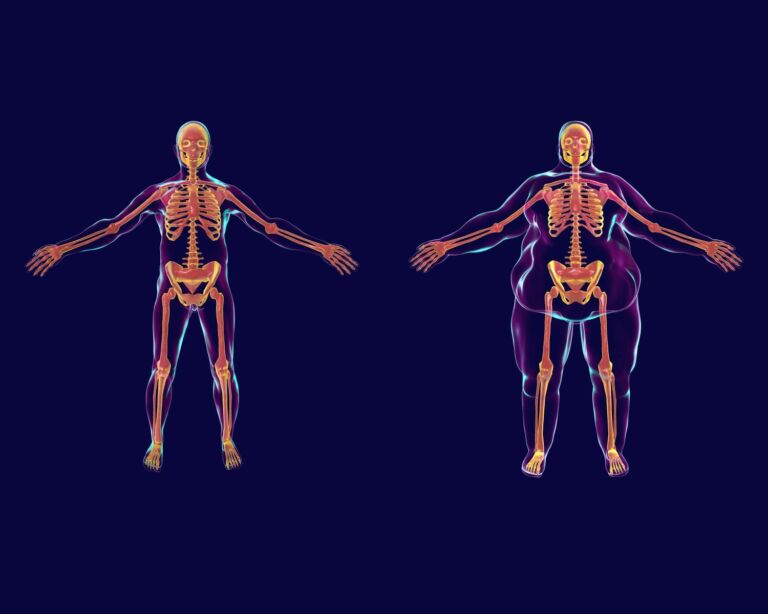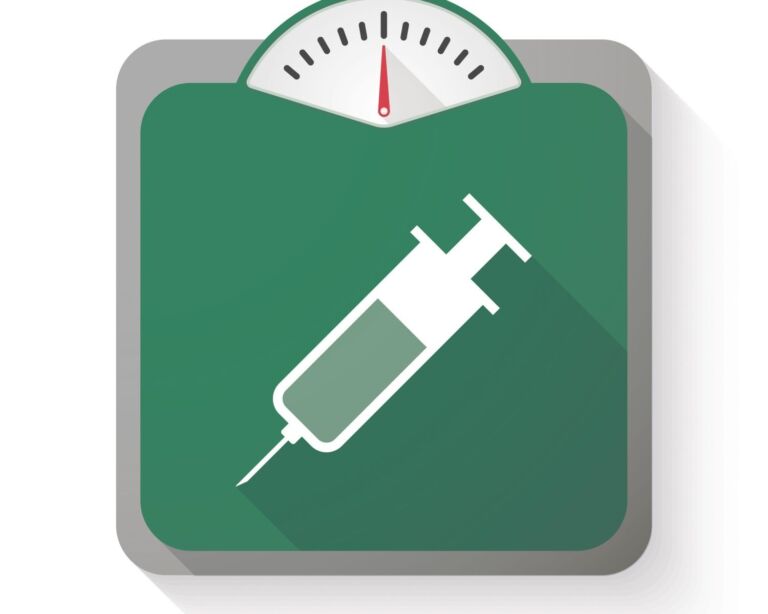In Switzerland, around 42 percent of the adult population is overweight. Eleven percent of those affected are obese. Among children and adolescents, eleven percent are also considered overweight. These figures are worrying, as obesity can significantly reduce quality of life and promote the development of various diseases.
What is obesity?
In the case of obesity, i.e. severe overweight, an excessive amount of fatty tissue accumulates in the body. A person is considered overweight (obese) if their body mass index (BMI) is over 30. The body mass index is calculated by dividing the body weight in kilograms by the height in meters squared. However, the BMI does not take into account age or the distribution of body fat and muscle mass.
Overweight and obesity increase the risk of various metabolic and cardiovascular diseases, and even certain cancers. If you want to assess your individual risk, you need to determine the fat distribution pattern as well as your body weight. For example, you can estimate your belly fat based on your waist circumference:
- From a waist circumference of more than 80 centimeters in women and more than 94 centimeters in men, the risk of secondary diseases is increased.
- Abdominal obesity significantly increases the risk of metabolic and cardiovascular diseases. This is the case for women with a waist circumference of 88 centimeters or more and for men with a waist circumference of 102 centimeters or more.
In cases of extreme overweight – i.e. obesity (morbid obesity) of the third degree – we also speak of adipositas permagna (Latin „permagnus“ = very large).
Obesity: causes and risk factors
Obesity occurs when we consume more energy in the form of calories than we use. The body stores the excess energy as fat in so-called fat cells. Known causes of obesity are unfavorable eating habits and lack of exercise. But there are other risk factors that can lead to obesity. These include, among others
- hereditary influences,
- psychological factors,
- certain medications and
- Hormonal / metabolic disorders.
Unfavorable eating behavior
Many people eat more than they need to cover their energy requirements. They also often underestimate the energy content of food and drinks. In addition, people with a higher weight usually eat faster and more frequently than people of normal weight. This disordered eating behavior plays an important role in the development of overweight and obesity. The stomach expands during food intake. The body sends impulses to the brain via hormones and nerves, which lead to a feeling of satiety. However, if we eat too quickly, we only feel full when we have already eaten more than we actually need. The ready-made foods that are widely available in Western countries also support the development of overweight and obesity, as they are generally not very filling but contain a lot of calories.
Lack of exercise
Lack of exercise is an important factor in overweight and obesity. This is because many people spend a large part of their working or leisure time sitting down – in front of the computer or television, for example. Energy consumption is correspondingly low.
Hereditary causes
Are fat parents more likely to have fat children? In fact, obesity is more common in some families than in others. Hereditary causes therefore presumably play a role in the development of obesity. Researchers assume that the individual basal metabolic rate of a person – i.e. the amount of calories that the body consumes at rest – is hereditary. Some people can eat more than others because they already consume more energy at rest. In addition, parents often pass on their unfavorable eating habits to their children.
Psychological factors
Whether it’s hunger pangs or frustration eating – psychological factors such as stress, anger, anxiety or boredom can also contribute to the development of overweight and obesity. This is because they are often the trigger for disordered eating behavior (binge eating disorder).
Variations in eating behavior
- Frequent eating (nibbling, „grazing“, „nibbling“, „picking“)
- Overeating at mealtimes: Lack of satiety
- Hedonistic hyperphagia: Overeating because it tastes good
- Sweet eating (especially sweets)
- Night-eating: recurrent episodes of nocturnal eating, which manifest themselves in eating after waking from sleep or excessive/over-eating after dinner
- LOC (loss of control) eating: eating with loss of control, although the amount of food consumed is objectively not large
- Emotional eating: Food intake as a reaction to negative emotions such as disappointment or feelings of loneliness
Medication as a cause
Certain medications can increase your appetite. This leads to increased food intake. The result is increased body weight. These drugs can increase your appetite:
- Antidepressants (medication for depression)
- Neuroleptics (medication for other mental illnesses)
- Glucocorticoids (cortisone-like drugs)
- Antidiabetics (medication for diabetes)
Hormonal and metabolic disorders
Certain diseases that disrupt the hormonal balance can also lead to overweight and obesity. These include, for example, hypothyroidism or Cushing’s syndrome, a disease that leads to an overproduction of cortisone in the body.
Other causes of obesity
The following factors can also play a role in the development of overweight and obesity:
- Pregnancy
- Bedridden for a longer period of time
- Stop smoking
- Operations in the hypothalamus area
- Lack of sleep
Symptoms: Recognizing obesity and overweight
Typical general symptoms of overweight and obesity are
- lower physical resilience,
- Joint problems,
- increased sweating and
- Mental problems.
Lower physical resilience
The bodies of people with obesity and overweight are less resilient. This often manifests itself in shortness of breath and rapid fatigue during physical exertion. Even everyday activities such as climbing stairs or bending down can be difficult for those affected.
Joint problems with obesity
Joint problems are a common consequence of obesity and being overweight. The excess weight leads to overloading of the joints, premature signs of wear and tear(osteoarthritis) and pain. The area of the lower spine, the hip joints and the knee and ankle joints are particularly affected.
Increased sweating
A typical symptom of obesity and overweight is increased sweating. Even with light physical exertion, overweight people tend to sweat more, even at low temperatures.
Mental and social consequences of obesity
Obesity and being overweight often have an impact on mental health and social life. Being overweight can lead to social exclusion of those affected. Possible consequences are reduced self-esteem, anxiety and insecurity in social interaction as well as psychiatric comorbidities.
Possible psychiatric comorbidities in obesity are:
BMI Calculator
Is your weight within the normal range?
Use our BMI calculator to find out quickly and easily whether your body weight is healthy.
Obesity diagnosis
If you have a BMI of 30 or more, you are obese. To minimize secondary diseases, it is important to reduce body weight. Discuss any measures with us. During the consultation, you will be asked in detail about your medical history and your previous lifestyle habits. Important topics include your eating and exercise habits and your family and professional environment. We also carry out various examinations, such as
- Measurement of blood pressure,
- Detailed blood analysis,
- ECG or
- Ultrasound of the liver and gallbladder
- psychiatric interview
We will use the information obtained to draw up a suitable treatment plan for you.
Obesity: prevention, early detection, prognosis
If you want to prevent obesity and overweight, you should adopt a healthy lifestyle with regular exercise and a balanced, low-calorie diet. Check your body weight regularly and counteract any slight weight gain at an early stage.
This will bring more movement into your everyday life:
- Go for a half-hour walk in the fresh air every day.
- Take your bike instead of the car.
- Use the stairs and not the elevator.
Obesity: progression and prognosis
Obesity and severe overweight increase the risk of various illnesses, such as
- Diabetes mellitus type 2
- Fatty liver
- Gout
- Cardiovascular diseases, such as
- Shortness of breath (dyspnea)
- Heavy snoring in connection with breathing interruptions (sleep apnea)
- Diseases of the bile ducts, for example
- Inflammation of the gallbladder (cholecystitis)
- Gallstones
- Reflux disease, inflammation of the esophagus (esophagitis)
- Joint diseases (arthrosis)
- Malignant tumor diseases in the following areas
- Chest
- Intestine (colon, rectum)
- Ovaries
- Uterus
- Kidney
- Prostate
Obesity also reduces life expectancy: the lifespan of 40-year-olds is reduced by three to six years. Severe obesity can even cost up to 20 years of life. The good news is that losing weight significantly reduces the risk of secondary diseases. Weight loss also usually has a positive effect on existing illnesses.
Obesity: treatment with a multimodal concept
Various therapies are available for the treatment of obesity and severe overweight, which often achieve the best results in combination. If your overweight corresponds to a BMI between 25 and 29.9, then we speak of so-called preadiposity. Here too, weight reduction (possibly under medical supervision) is advisable, especially if
- you also suffer from obesity-related illnesses such as type 2 diabetes mellitus or high blood pressure,
- you have illnesses that are aggravated by being overweight,
- you have too much belly fat or
- you feel emotional and social pressure.
Self-help groups
The exchange with people who are affected by the same disease can be a great support in coping with the disease. Advice on finding a suitable self-help group is available from Selbsthilfe Zürich. Self-Help Zurich and the University Hospital Zurich are cooperation partners in the national project „Health literacy thanks to self-help-friendly hospitals“.




